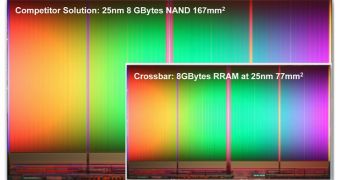Dynamic random access memory is faster than all other sorts of memory technologies, especially magnetic storage used in HDDs and Flash technology used in SSDs. Crossbar wants to change that though.
Crossbar has just introduced a resistive random access memory technology (Resistive RAM) that does not only exceed the capacity of today's DRAM, but is non-volatile as well.
What that means is that, unlike today's memory modules, the chips revealed by Crossbar don't lose the data once the PC is shut down.
It's also worth noting that the Resistive RAM has a simple, three-layer structure that allows it to be stacked three-dimensionally: a non-metallic bottom electrode, an amorphous silicon switching medium and a metallic top electrode.
This is what allows multiple terabytes of data to be stored inside a single chip.
That will come later though. For now, we'll have to "settle" for 1 TB chips, which can hold 250 hours of HD movies on a single IC the size of a post stamp. We don't really need to explain why this is a major breakthrough.
"Non-volatile memory is ubiquitous today, as the storage technology at the heart of the over a trillion dollar electronics market - from tablets and USB sticks to enterprise storage systems," said George Minassian, chief executive officer, Crossbar, Inc.
"And yet today's non-volatile memory technologies are running out of Steam, hitting significant barriers as they scale to smaller manufacturing processes. With our working Crossbar array, we have achieved all the major technical milestones that prove our RRAM technology is easy to manufacture and ready for commercialization. It's a watershed moment for the non-volatile memory industry."
Despite this being a RAM technology, it will be used in SSDs and embedded storage chips for smartphones and tablets. Cloud computing applications are a sure thing too, as are wearable computing gadgets like Google Glass.

 14 DAY TRIAL //
14 DAY TRIAL //